Vol 1 No. 40 TROPIC LIGHTNING NEWS November 25, 1966
Index
[Many of the photographs in this issue of Tropic Lightning News were too dark
or blurry to reproduce clearly. They have been included only to give a
sense of the activities in the Division.]
Posthumously
Highest Honor To Fernandez
Sp4 Daniel Fernandez, who this week was posthumously awarded the nation’s
highest award, the Medal of Honor, was one of those rare young men who was
admired and respected by his contemporaries.
He was quiet, competent, unselfish. cheerful, the type they choose as
president of the senior class.
When he died on February 18 this year, he was a rifleman for C. Co, 1st Bn. (Mech),
5th Inf., and everyone who had known him, mourned him.
He was not a career soldier. He used to joke with his friends that he was in
the Army for three years because he had flipped a coin with his draft board, and
lost. Actually he, had enlisted for three years.
While he was in the Army he wanted to be a good soldier. He spent hours at
Schofield Barracks in Hawaii, pouring over infantry handbooks.
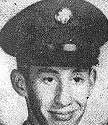 His platoon leader, Lt. Joseph V. Dorso of Norwalk, Conn., called him “the
type of guy I could always count on no matter the situation.” SSgt. David M.
Thompson of Belair N.Y., who used to go sky diving with him in Hawaii, said
simply, “Danny was my best man.”
His platoon leader, Lt. Joseph V. Dorso of Norwalk, Conn., called him “the
type of guy I could always count on no matter the situation.” SSgt. David M.
Thompson of Belair N.Y., who used to go sky diving with him in Hawaii, said
simply, “Danny was my best man.”
The members of his squad, a tight little group of 15 men, one subsection of a
huge division, looked upon him as a father confessor. Even those who were older
than he called him “Uncle Dan” and went to him with their troubles and their
complaints.
Specialist Fernandez had been in VN once before as a volunteer machine gunner
on an Army helicopter. So it was not surprising that he was one of 16 men who
volunteered for an ambush patrol that was sent out from Cu Chi just after
midnight on February 18, 1966.
About 7 a.m., as the patrol lay in wait in a jungle clearing for the Viet
Cong, Sgt. Joseph T. Benton of Hetford, N.C., spotted seven VC in the woods
behind a burned out hut. He began firing his machine gun, and then reached for
a hand grenade.
Before he could pull the pin out, a Communist sniper killed him. Specialist
Fernandez crawled to one side of the hut to cover the right flank, and Sp4 James
P. McKeown of Willingsboro, N.J., moved into place on the other side. Behind
the hut PFC David B. Masingale of Fresno, Calif., the platoon’s 18-year-old
medic, bent over Specialist Benton.
A moment later, the Viet Cong opened up with machine guns, and a bullet
smashed into the leg of Sgt. Ray E. Sue, knocking him to the ground. Sp4 George
E. Snodgrass of Pompton Lakes, N.J., who had come up with Sgt. Sue to try to get
Specialist Benton out, hit the dirt.
Now all five men were pinned down in an area no bigger than a living room.
PFC Masingale treated Sgt. Sue; two flank men riddled the bushes and Specialist
Snodgrass fired behind Specialist Benton’s body.
At that instant, a grenade fired from a rifle by one of the guerrillas landed
by Specialist Fernandez’ leg. He got up on all fours, trying to escape, but he
hit the grenade with his ankle, knocking it to within three feet of the group
around Specialist Benton and Sgt. Sue.
Without hesitation, so quickly that PFC Masingale is sure he didn’t have time
to consider the consequences of his action, Specialist Fernandez shouted, “Move
Out!” and threw himself onto the grenade.
When the others reached him after the explosion he was still conscious.
Specialist Snodgrass helped to make a litter from three shirts and bamboo pole
and dragged Specialist Fernandez towards an open area where a helicopter could
land.
“It hurts,” the wounded man said, “I can’t breathe.”
Specialist Snodgrass, a devoted Roman Catholic who often went to mass with
Specialist Fernandez told him to a “make a good act of contrition” because no
priest was present.
“I will,” Specialist Fernandez said, and shortly after died.
For this action, his last, Daniel Fernandez was awarded the Medal of Honor.
Specialist Fernandez’ parents live at Los Luns, N.M.
‘Attleboro’ Passes 2 Marks
Operation “Attleboro II,” the largest operation of the VN war, passed two
milestones this week as the Viet Cong death count topped 1000 and enemy rice
captured climbed over the 3,000,000 pound mark.
More than 10,000 American troops, including elements of the 25th division,
have been roaming the dense jungles of Tay Ninh province since the first week of
November when fiery battles broke out between units of the 27th Infantry and an
estimated VC battalion.
Units of the 1st Bn (Mech), 5th Inf, shined for the 25th this week as they
destroyed an enemy meeting area after the location had been softened by B-52
strikes.
The Air Force bombers cut a path through the war zone’s thick jungle some 75
miles northwest of Saigon. The 5th Mech came across 20 camouflaged huts
equipped with sleeping, eating and meeting facilities. Most of the huts had
been crushed under jungle trees felled by the air strike. Buildings, bunkers
and air raid shelters were destroyed.
Later, the 5th Mech discovered a Viet Cong rice processing mill and
destroyed it.
Moving on a sweep one mile from its tactical command post, Co A of 1/5th
dismounted its armored personnel carriers and searched through the thick jungle.
The company’s first platoon came upon a large building. Inside was a wooden
mill. Its wheels were equipped with louvers and a spout into which raw rice was
poured.
On the floor of the building were 20 huskers - round, hollowed out concrete
blocks into which rice from the mill stone was poured. Another wooden wheel
placed into the huskers and turned back and forth over the rice by a rope pulley
completed the VC mill.
The Mech discovered some 5000 pounds of rice in the area.
| In the field, in base camp, a Happy “Tropic Lightning” Thanksgiving, 1966. | 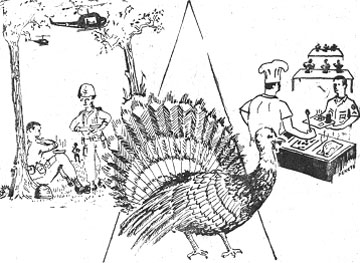 |
|
|
|
LATEST REPORTS |
|
Through November 22 |
| Operation | Province | Began | FC | KIA | VCC | VCS |
| Attleboro | Tay Ninh | Sept. 14 | L | 570 | 68 | 61 |
| Lanikai | Long An | Sept. 15 | L | 22 | 6 | 96 |
| Paul Rev. IV | Pleiku | Oct. 18 | L | 1068 | 42 | 83 |
Gen. Knowles Commands 196th;
2nd Assistant Div. CO Named
Brig. Gen. Richard T. Knowles, former II Field Force Chief of Staff, assumed
command of the 196th Light Infantry Brigade at Tay Ninh, and Col. Donnelly P.
Bolton has become the second assistant Division Commander of the 25th Infantry
Division.
In taking over one of the Army’s newest combat units, General Knowles
replaced Brig. Gen. Edward H. deSaussure Jr., who has been reassigned to I Field
Force.
Gen. Knowles is a graduate of the Artillery School’s basic and advanced
courses, the Command and General Staff College, and the U.S. Army War College.
He completed airborne training in 1962.
This was his third time in combat. During World War II he served with the
16th Tank Destroyer Group in Europe and commanded the 96th Field Artillery
Battalion in Korea.
During his military career, the general has been awarded the Legion of Merit,
Silver Star Medal, Bronze Star Medal with “V” device, Purple Heart Medal and a
Presidential Unit Citation.
Col. Bolton was assigned to Headquarters, I Field Force, Vietnam, in January
1966.
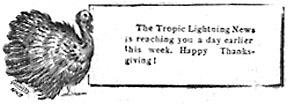
Page 2 TROPIC LIGHTNING NEWS November 25, 1966
Decorated
| SILVER STAR | |
|
1st. Lt. Michael J. Kowalchik, Co. B, 2nd Bn, 27th Inf, SSgt.Wayne A. Frizielle, Co. A, 1st Bn. 27th Inf. |
PFC Raymond R. Brown, HHC, 2nd Bn, 27th Inf. |
|
BRONZE STAR MEDAL WITH 'V' DEVICE |
|
|
Capt. Ardeen R. Foss, HHC, 25th Inf Div. Capt. Robert P. Garrett, Co B, 1st Bn, 27th Inf. Capt. Lowell J. Mayone, HHC, 1st Bn, 27th Inf. 2nd Lt. George E. O’Neill, C Btry, 1st Bn, 8th Arty. SSgt, Howard Garrett, Co A, 2nd Bn, 27th Inf. Sgt. Richard A. Hale, Co A, 1st Bn (Mech), 5th Inf. Sgt. Augustine Russo, HHC, 2nd Bn, 27th Inf. (Posthumously) |
Sp4 Franklin Gore, Co A, 1st Bn, 27th Inf. PFC Clarence Bishop, Co A, 1st Bn, 27th Inf. PFC John A. Fekete, HHC, 2nd Bn, 27th Inf. PFC Thomas Holloman Jr, Co A, 2nd Bn, 27th Inf. PFC Robert D. Johnson, HHC, 2nd Bn, 27th Inf. PFC Adolph Rios, HHC, 1st Bn, 27th Inf. |
| ARMY COMMENDATION MEDAL WITH 'V' DEVICE |
|
|
1st Lt. Jack R. Carollo, 15th PI Det. SFC Ray D. Lynch, C Btry, 1st Bn, 8th Arty. Sgt. Thaddeus Jones, Co C, 1st Bn (Mech), 5th Inf. Sgt. Donald Payne, Co C, 1st Bn (‘.Meth), 5th Inf. Sp4 Carl F. Buckmaster, Co C, 1st. Bn (Mech), 5th Inf. |
Sp4 Patrick J. Devereaux, Co C, 1st Bn (Mech), 5th Inf. |
|
PURPLE HEART |
|
|
Capt. Calvin F. Kennedy, HHB, 7th Bn, 11th Arty. Sgt. Larry Estep, Co A, 1st Bn (Mech), 5th Inf. Sgt. William Moon, Co C, 1st Bn (Mech), 5th Inf. Sgt. William E. Provost, HHC. 1st Bn, 27th Inf. |
Sp4 George K. Newman, Co A, 2nd Bn, 27th Inf. Sp4 Larry Page, Co C, 2nd Bn, 27th Inf. Sp4 Felix Prus Jr, Co A, 4th Bn, 23rd Inf. PFC James A. Owens, Co A, 4th Bn, 9th Inf. |
Free World Forces Work Hard Toward Freedom of Vietnam
(Editor’s Note: This is the first in a series three of articles concerning
the work of the Free World Forces and what they are accomplishing in the
Republic of Vietnam.)
The 370,000 free world military assistance troops in Vietnam are there to
support the armed forces and the people of Vietnam in their struggle against
communist aggression. The commanders and troops of the several nations are
working together in coordination and harmony that is unprecedented in history.
Their successes on the battlefield attest to their morale, fighting spirit, and
professionalism.
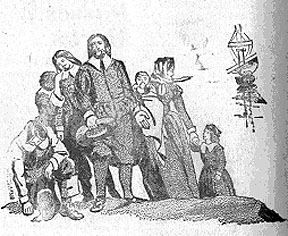 But, with our interest in this international effort, there may be a tendency
to lose sight of the fact that the major burden of war is still being borne by
the armed forces of the Republic of Vietnam. The Vietnamese regular and para-military
forces and police are fighting daily against the insurgent enemy and
aggressors. They fight to provide security for their people and protection for
installations so important to the life of a nation, any of which may be the next
target for enemy attack or sabotage.
But, with our interest in this international effort, there may be a tendency
to lose sight of the fact that the major burden of war is still being borne by
the armed forces of the Republic of Vietnam. The Vietnamese regular and para-military
forces and police are fighting daily against the insurgent enemy and
aggressors. They fight to provide security for their people and protection for
installations so important to the life of a nation, any of which may be the next
target for enemy attack or sabotage.
These are the forces which fight the forgotten war day after day. They have
been fighting for over a decade. They will continue to fight until the people
of their country can be free to work for themselves and their children.
Month in and month out, the Republic of Vietnam armed forces exact a greater
toll from the enemy than do their allies – and they pay a higher price. During
the first nine months of this year, the Republic of Vietnam forces conducted
several tines as many battalion-sized or major operations than did the other
free world forces. The cost to the Republic of Vietnam was 11,400 killed in
action or missing, while her allies lost 4000.
The performance of the Vietnamese forces demonstrates growing professionalism
and spirit. The casualties reflect the fact that the Republic of Vietnam armed
forces today are fighting more aggressively and in more difficult areas than
ever before.
Next Week : Govt. Gain
Editorial
Our Blessings
Do Americans place too much emphasis on Thanksgiving Day? We think not.
Americans traditionally observe this holiday for a number of reasons - and very
good ones. They have many things to be thankful for.
Among these are modern housing, sleek cars, television sets, a wonderland of
household appliances and comforts. We are thankful for these blessings and the
free competitive society that puts such miracles within our reach.
But there is more. Our heritage is really our wealth. We give thanks not
alone for the good life but for our way of life - a free society. Millions of
people on earth do not have these blessings. We wish freedom for all people.
That is why we are here at Cu Chi, Pleiku and Tay Ninh fighting to preserve freedom. We don’t think Thanksgiving Day is
overstressed. We are registering thanks for our bountiful blessings.
Our forefathers first gave thanks for their good fortune at Plymouth, Mass.,
in 1621. We are still doing it today as citizens of a prosperous, thriving
United States of America that is free.
| WINNER - Brig. Gen. George G. O’Connor, ADC, prevents a volleyball trophy to 1st. Sgt. George Dizon, Div HHC. The “Tropic Lightning” volleyball team, the “Kanakas,” played Vietnamese and French teams in Saigon, finishing in second place. |
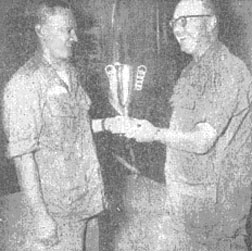 |
Hey, Soldier, Get Your Gun
Less than forty days remain to claim privately owned weapons now in custody
of the 377th Air Police Squadron, Tan Son Nhut Air Force Base.
The weapons must be claimed by the owners or their designated
representatives. Representatives must have written authority to obtain the
weapon. This should be a letter from the representative and carrying the
owner’s signature as it appears on the weapon receipt.
The weapon will be released on presentation of such identification. The
owner then must re-register it with his organization headquarters where it will
be secured in a unit arms room.
Weapons not claimed by the December 21 deadline will be considered as
abandoned property.
Weapons can be claimed at Building 19, Cantonment 1, Tan Son Nhut AFB.
| The TROPIC LIGHTNING NEWS is an
authorized publication of the 25th Infantry Division. It is published
weekly for all division units in the Republic of Vietnam by the
Information Office, 25th Infantry Division, APO U.S. Forces 96225.
Army News Features, Army Photo Features and Armed Forces Press Service
material are used. Views and opinions expressed are not necessarily
those of the Department of the Army. Printed in Saigon, Vietnam, by
The Vietnam Guardian. Maj. Gen. Fred C. Weyand . . . . Commanding General Maj. William C. Shepard . . . . . . Information Officer 1st Lt. William H. Seely III . . . . Officer-in-Charge Sp4 David L. Kleinberg . . . . . . . Editor Sp5 Jimmy Edwards . . . . . . . . . Editorial Assistant Sp4 Adrian E. Wecer . . . . . . . . Editorial Assistant |
Page 3 TROPIC LIGHTNING NEWS November 25, 1966
Tale of Horror
Viet Boy Flees V.C.
By PFC Vern Shibla
A small, tired Vietnamese boy of 13, wet and muddy from swimming across the
river that runs along the southwest portion of the division’s base camp at Cu
Chi, and carrying the only things he had left in the world, five simple, worn
shirts, wandered into the perimeter of the 4th Bn, 9th Inf, “Manchu” recently.
Shaking and cold, he was brought to the Manchu’s headquarters where he told
this story to the Vietnamese interpreter from the lst Bde, SSgt. Nguyen Tuan.
His name was Soan, and he had been playing near his home. His parents, rice
farmers, had just returned from a long day working the rice when five Viet Cong
came to their house. The young lad was frightened and hid in a large water
urn. He didn’t know why the VC were there or what they wanted; he only knew he
was scared.
After what seemed like an eternity to this young boy, the Viet Cong left. He
cautiously climbed out of the water urn and walked around to the front of his
house to find his parents. As he reached the front he saw a sight that sent him
into shock. His parents, both mother and father, were lying dead in a pool of
blood. The Viet Cong had cut their throats with a machete.
Soan had no one to turn to. He didn’t know where his brothers and sisters
were. Perhaps the Viet Cong had killed them too. Fearing the VC would return
and find him there, he took one dong from his mother’s mutilated body and fled
to the jungle.
Remembering an uncle who lived near Saigon, Soan began walking in that
direction. He wasn’t sure of the address, but it was his only hope. One day
went by, than another. Soan became weary from walking.. He had little to eat
and slept in the jungle at night because he was afraid the Viet Cong would find
him.
On the third day of his ordeal, Soan came to a huge clearing in the jungle -
the 25th’s base camp at Cu Chi. Too tired to be scared and too hungry to be
cautious, Soan swam the river and began walking toward the many tents he saw in
the distance. As he approached the barbed wire that runs across the 4th Bn, 9th
Inf, perimeter he was picked up by a man on bunker guard and brought to the
“Manchu” headquarters.
After Soan finished his story, he drank a soda and laid his wet clothes on
sand bags to dry and fell asleep on a wooden bench, feeling secure that at last
he had found someone to help him.
2/27th Point Man Acclaimed ‘Best’
It’s not an easy job to be a point man. To be a good one is rougher yet.
The men of the second platoon of “Charlie” Company, 2nd Bn, 27th Inf,
“Wolfhounds” claim Sp4 Vince Robbins is the best point man in the division.
Once when the Wolfhounds were caught by surprise, Specialist Robbins did his
share to eliminate the VC advantage. “We were on a patrol in the Hobo Woods,”
said Robbins, “and were suddenly pinned down by automatic weapons in a concealed
bunker to our front. Someone had to sneak around the bunker and surprise the VC
from the rear so Specialist Robbins and four friends volunteered.
“When we had the bunker flanked, I asked the rest of the platoon to stay
where they were and cover me while I went around to throw a grenade in. By the
time I thought I’d crawled a mile and had finally reached the bunker, I realized
I was out of hand grenades. So I threw a smoke grenade in to flush the VC out.
As soon as they crawled through the opening, the rest of the platoon cut them
down. We killed the three-man crew,” he concluded.
| FRIEND - SSgt. Billy R. Stinnett (r) of Co A, 1st Bn., 14th Inf, offers one captured North Vietnamese Army (NVA) soldier a cup of water. The 16-year-old, khaki-clad VNA was left behind by his regiment when he could no longer walk. (Photo by PFC John Newman) |
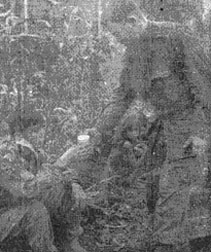 |
Double Doubles At 196th
It’s not too unusual to find two brothers serving together in Vietnam. But
it is unusual to find two pairs of brothers one pair of which is a set of twins
serving in the same unit.
The four soldiers, all inducted into the Army in September 1965, are assigned
to the 196th Lt Inf Bde’s Co A, 4th Bn, 31st Inf, at Tay Ninh.
The twins are Sp4 Dennis McGown and PFC Glennis McGown of Romulus, Mich.
“Back at Fort Devens,” said brother Dennis, “people had trouble getting us
straight. Now after arriving in Vietnam to join the division we’re pretty well
known.”
Dennis, 22 is a truck driver in the company. Glennis, who is a half-hour
older, is a radio-telephone operator.
The two other brothers serving in the “Go-Go” Company have an easier means of
being identified. One is known as “big boat” and the other as “little boat.”
“Big boat” is Sp4 Charles W. Bolton, 23 and “Little boat” is Johnny Bolton of
Brandywine, W. Va. Both are acting squad leaders.
Mud Makes Job For S&T Motor Pool
 |
 |
|
Rush repairs for... |
...More repairs |
Mud, miles and missions make misery for mechanics. This sums up the woes
expressed by the men of division’s Supply and Transportation (S&T) battalion
motor pool.
“Our trucks have logged more than 583,000 miles since arriving in Vietnam
last January,” explained Sp4 Robert C. Pietras, 23, of Hicksville, N.Y.,
battalion dispatcher. They travel over many roads but the most frequently used
is the 23-mile stretch between Saigon and the “Tropic Lightning” base camp at Cu
Chi.
“The Division has been primarily responsible for transporting its own
supplies and rations and thus far some 42,000 vehicles have made the run,” one
transportation officer pointed out. Of this number the S&T Bn accounted for
more than 60 percent of the resupply tonnage moved.
Sp4 Clyde C. Floyd, 23, of Naples, Fla., a mechanic for the battalion,
speaking of the problems that arise with the trucks, said, “The heat and
stop-and-go traffic really raises cane with the cooling systems and brakes of
the vehicles. It is sometimes necessary to change brakes on a truck as often
as every two weeks.
“When the wheels are submerged in mud, a certain amount seeps through into
the brake drums. When the water runs out or dries up, the sand that remains
becomes an abrasive that quickly grinds down the lining on the brake shoes.
Often the hydraulic wheel cylinders are damaged in the process.”
Lining brake shoes and rebuilding or replacing wheel cylinders is a long and
exacting process. It is the responsibility of the mechanic to see that the
truck is fully safe, not only for the driver and passengers that will be riding
in the vehicle, but also for every member of the convoy who will be affected by
that truck’s performance. It is also necessary to complete repairs as quickly
as possible since the vehicle is rendered inoperative by brake failure.
“Not much can be done about the rains,” says one of the other mechanics, but
soon the monsoon-season will be over and we will have only the heat and dust to
contend with.”
Page 4-5 TROPIC LIGHTNING NEWS November 25, 1966
[This issue of Tropic Lightning News was scanned from a bound library volume provided by the 25th Infantry Division Museum. Portions of the photographs and stories on pages 4 and 5 are missing. They were printed across the center of the 2-page-wide sheet and were hidden from sight because of the way the paper is bound into the book - the book could not be safely opened far enough to see that part of the page.]
Combat Course Greets Replacements
Newly arrived replacements are undergoing the orientation training to become
familiar with the new environment and the types of weapons that are used in the
Pleiku area.
Replacements are processed through a five-day cycle, covering a different
phase of training each day, and utilizing both classroom and and practical work.
The first day covers a wide variety of orientations on the history of the 3rd
Brigade Task Force, the local facilities of the base camp and the town of Pleiku,
judge advocate general and Red Cross functions, and lastly, a class on personal
hygiene and field sanitation.
After a lunch break, the men return to the classroom for mechanical training
with the M-16 rifle and M-79 grenade launcher. They also receive a short
session on the PRC-25 radio (the most common used by brigade infantry units on
patrols), grenades and airmobile operations using helicopters.
On the second day, new arrivals are familiarized with the claymore mine and
the M-72 light anti-tank weapon. That afternoon the use and availability of
fire support is discussed. Following are briefings on demolitions, mines, booby
traps and North Vietnamese Army tactics and weapons.
The next day finds the soldiers firing their individual weapons. [The rest of this story is hidden in the bound fold of the page...]
|
Photos by SP4 Dale V. Sutphin |
| ANYBODY HOME - Students check out a Montangnard house while on a training mission near Pleiku. The students, all newly arrived replacements, now undergo a week-long orientation on Vietnam combat. |
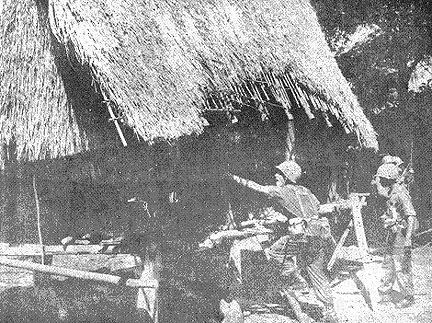 |
 |
MILESTONE - Sp4 Milton R. Rayburn, the 100th trainee at the Replacement Training Center, prepares to throw a hand grenade. |
| NO PLACE LIKE HOME - Newly arrived replacements wade through knee-deep water during a week-long orientation at the 3rd Brigade Task Force training center. |
 |
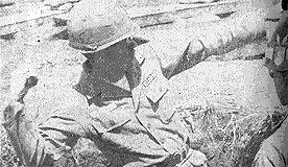 |
WIND UP - SSgt. Roy L. Greenfeather, grenade throwing instructor, observes a student's form. |
| HELPING HAND - A trainee from the 3rd Brigade Task Force replacement center helps a fellow soldier up a muddy bank while on a training mission east of Pleiku. |
 |
Page 6 TROPIC LIGHTNING NEWS November 25, 1966
Bird Dogs Spot Targets for Jet
By Sp4 Richard Calvo
A high-wing plane circles at 2000 feet and soon three vapor trails are seen
cutting the sky above. An amazing air show is about to begin with “Bird Dogs”
calling the shots.
“Bird Dogs” are Air Force O1E light single engine aircraft used for Forward
Air Control (FAC). The pilot’s duties consist of finding and marking targets
and assisting fighter bombers to destroy enemy positions.
“Fighter bombers fly too fast to spot enemy movements or positions,”
explained Maj. Ramon L. Koenig of Windsor, Colo., an Air Force FAC pilot, so it
becomes our job to lead them to their targets.”
After circling and recircling the FAC pilot radios the bombers to watch for
his smoke. Then by decreasing the speed of his engine and pushing his stick
forward, he puts the small aircraft into a steep dive. The plane quietly starts
downward at a stomach-bubbling rate of descent. Then with a pull of a
triggering device, rockets pop from beneath its wings and toward their target.
White smoke billows from the enemy position, as the “Bird Dog” pulls out of
its dive and quickly gains attitude to give the now diving fighter bombers room
to begin their runs.
“Twenty meters north of smoke,” radios the FAC pilot as he watches the first
set of bombs fall short of their mark. Then banking with wings almost
perpendicular to the earth below the pilot watches the next set of bombs shatter
their target.
“Good hit!” blurts out the radio as the FAC pilot flies his craft high to
carefully observe the surrounding area for fleeing VC.
At the end of the mission the FAC pilot returns to the Cu Chi Airfield.
Since the “Tropic Lightning” Division arrived in Vietnam in early February,
FAC pilots have flown over 2000 missions in the Cu Chi area without suffering a
single loss.
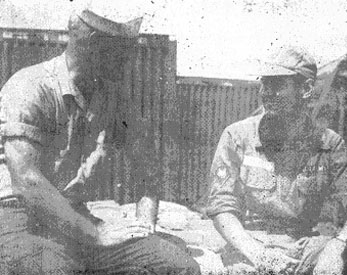 |
FATHER AND SON - Sp4 Howard D. Pittman of Btry D, 2nd Bn, 9th Arty, chats with his visiting father, Builder 2nd Class Perry H. Pittman, who is newly assigned to the Naval Support Activity at Da Nang. (Photo by Sp4 Dale Sutphin) |
Father, Son Re-Unite at 2/9th
Builder 2nd Class Perry H. Pittman’s first question at his new station at Da
Nang, was, “Can I get a three-day pass to see my son in Pleiku?”
The detachment commander of the Naval Support Activity gave his approval and
the Seabee hopped on an airplane. He checked the 90th Replacement Bn. locator
at Long Binh and learned his son was assigned to the 2nd Bn., 9th Arty.
Spending the night at Long Binh he was looking forward to the next day when
he would see his only son again.
At 1:30 a.m., Pittman heard some explosions off in the distance, “Long Binh
is being mortared,” cried a soldier. But the attack didn’t last long and the
Seabee was soon on a plane bound for Pleiku.
“when I got to the 3rd Brigade’s base camp, I found the 9th Artillery’s area
and asked them, “Where’s my son?” Specialist Pittman was undergoing training at
the brigade’s Replacement Training Center.
“As I was firing an M-16 rifle at the range, someone called out my name and
told me to report to my unit,” the specialist said. “I didn’t know what was
going on.”
“When I got to the orderly room, I saw my dad. Boy, was I surprised!”
The Seabee said his wife, Geraldine, doesn’t particularly like the idea of
both being in Vietnam, but he told her, “Somebody has to be over here to look
after the boy.”
Pittman later said, “We figure that by staying here (Vietnam) at the same
time, we at least get to see each other every so often. The only thing I would
like better during this tour would be to be attached to the 3rd Brigade and
serve right here with Howard.”
RC Girl Departs Cu Chi
One of the founders of the Cu Chi Red Cross Clubmobile has begun her long
journey back to the United States after serving her 12-month tour overseas.
Miss Vicky Olson, 24, of Rochester, Minn., arrived at Cu Chi in early
September after serving with the Red Cross USO in Korea. As program director,
Miss Olson conducted the well-known Saturday morning “coffee call” with her
traditional Red Cross hospitality.
Prior to her departure, a small ceremony was given in her honor at Division
Headquarters. During the ceremony, Col. Thowas W. Mellen, the Chief of Staff,
presented Miss Olson with a letter of appreciation from the men of the “Tropic
Lightning” Division.
Miss Olson plans to return home to her family and “just relax for a while.”
Re-Up Sgt. Talks Bonus
“If you need money, don’t gamble. You may be eligible for a $6000
reenlistment bonus.”
SFC Don E. Cunningham, 196th Lt Inf Bde reenlistment NCO, works with this in
mind daily. In one month he reenlisted seven out of eight eligible reenlistees.
The month before, he signed up four out of four eligibles.
 |
CAPTURED FLAG - Lt. Col. Gilbert Procter (l), commander of the 1st Bn, 14th Inf, and Capt. Ora L. Boss, Co A, 1/14th commander, display a captured Vietcong Flag. Co A captured the flag from North Vietnamese Army (NVA) forces on a recent mission near Pleiku. |
196th PX Making Big Gains
“Count ‘em up and move ‘em out...” These are familiar words heard by men of
the 196th Lt Inf Bde as they pass by the brigade post exchange.
The “Charger” team has made remarkable progress in its first five weeks of
operation. During this time 10 branch PX’s with a $217,000 inventory were
established for the units of the brigade.
The PX staff is headed by Capt. Carter Brantner of Atlanta, Ga., and Lt.Andy
Lazarchick of Rahway N,J., both of whom work 14 hours a day, seven days a week
with the other men of their 14-man team.
The team relies mainly on military convoy, and civilian trucking firms to
convoy the few luxury items needed daily.
As Capt. Brantner has stated, “Although we are able to get in some items to
keep the troops taken care of, we actually haven’t started receiving quantities
to support them the way we would like to.
“The situation should improve when we open our central store,” promised Capt.
Brantner. “Then we will be able to stock the real luxury items like cameras,
tape recorders, TVs, and radios.”
The light brigadesmen will patiently wait knowing that their PX team is on
the job day and night to make things a little better for the men at Tay Ninh.
PFC’s Ingenuity And a Dollar Result in Improved Speaker
Know-how, ingenuity, and a dollar’s worth of radio components were all PFC
Leonard Williams of Detroit, Mich., needed to build his own field radio speaker
system.
PFC Williams, of Co A, 3rd Bn, 21st Inf, is a radio telephone operator (RTO).
Thinking that the size and weight of the Army’s standard radio-telephone
speaker could be improved for field operations he decided to build a replacement
for it. In a small C-Ration can he installed a three-ounce speaker.
The result? His new speaker weighs some 15 ounces less and has a higher
volume than the conventional Army speaker. It uses a transistorized
amplification system.
Thus far, the RTO has baptized his invention through three operations. “lt’s
very handy in the field,” he says. “It’s pocket held, doesn’t get tangled up in
the jungle, and makes it possible for me to perform other jobs while monitoring
the radio.”
Capt. Emil Gregg, Co A commander and for whom PFC Williams is RTO, also has a
high regard for the gadget. “lt has such a great volume that the RTO doesn’t
have to be close to me and I can still hear the transmission. Even during a
rainstorm, you can hear clearly any communications from higher headquarters.”
Page 7 TROPIC LIGHTNING NEWS November 25, 1966
1/35th Finds Cong Food, Aid Supplies
Co B, 1st Bn, 35th Inf, deprived the North Vietnamese Army (NVA) of large amounts of medical and food supplies during a recent four-day mission.
While on patrol during the first day, elements of the “Cacti Green” came upon
a Vietnamese hut. The 3rd platoon moved in to search and secure the area. In
the process, they were confronted by two NVA soldiers. A firefight resulted in
which both enemy were killed.
After the action, the platoon made a thorough search of the area. The
infantrymen discovered a cave containing nine cases of medical supplies (595
bottles of penicillin, 2000cc of dried blood plasma, and two bottles of
morphine) 400 pounds of salt and various enemy documents.
Two days later part of the 1st platoon was patrolling the perimeter of their
base case camp while the remainder moved ahead. Minutes after they had taken
cover, two NVA soldiers came down the path.
Shots rang out, fatally wounding one while the other escaped.
Hearing the shots, the rest of the platoon rushed to the scene. They checked
the dead enemy and found two weapons and two packs of rice.
The reconnaissance platoon of HHC, working in the same area, joined with the
1st platoon and the units went after the escaping soldiers.
A 400-yard sweep of the area was made before the escapee could be found.
Although he was still armed with two grenades he was apprehended, disarmed and
questioned.
The prisoner stated that there were seven other NVA troopers in his group.
After the first contact was made they had separated.
Policy Changes on Long Tour Drops
The policy on an early release of enlisted overseas returnees from Long tour
areas has been changed from a maximum of 90 days to 30 days. This is due to
shortages in certain enlisted grades and critical military occupational
specialties and to insure the maximum use of trained enlisted resources.
(ANF)
Medic Brings Good News
Sp6 Warren Raney has what he calls the “most gratifying job a medic could
have.” He is the division’s liaison NCO to any hospital where “Tropic
Lightning” soldiers are patients.
“I do everything from making up rosters to taking messages for these guys,”
explained the specialist. “I let them know how their units are doing and the
latest sports news. If there’s something I can’t answer, I find the answer and
let them know as soon as possible.”
| HOT MEAL - Sp4 Glen Stucky, a cook for HHC, 2nd Bn, 35th Inf,, prepares a tasty meal for the men of his unit. | 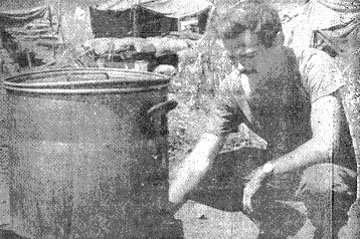 |
Sweden-Trained Chef Adds Talents to Pleiku Unit Chow
Of all the gripes soldiers make, probably none is heard more often than the
complaint about Army chow. The man usually on the receiving end is the cook,
who other members of the unit seem to think got his training in a cement
factory.
This is not the case, however with Hq. Co, 2nd Bn, 35th Inf. Their cook Sp4
Glen Stucky has been in the Army for two years but has been cooking for ten.
He received his training at the Culinary School of Fine Art in Stockholm,
Sweden. The school’s nine-month course counts among its alumni many of the
world’s fine chefs.
Before entering the Army, Specialist Stucky used his talents at the Hotel
Utah in Salt Lake City and the Brown Palace, Denver.
Specialist Stucky tries to bring out the highlights in the food he prepares
by using whatever seasoning and spices he can find. He admits that he doesn’t
have the same ingredients to work with here in Vietnam, but thinks the Army does
a good job with what it has.
Considering the fact that this is Vietnam, the specialist is amazed that the
troops are getting such good meals. Even out in the field they get one hot meal
a day and most of the men in the battalion get eggs and bacon for breakfast
every morning.
Specialist Stucky wouldn’t want to be doing anything other than cooking, even
with huge Thanksgiving and Christmas meals to prepare.
Jeep Shows ‘War Paint’
Of the many jeeps in the F Trp, 17th Cav, motor pool one in particular stands
out from the rest: On its side are painted the silhouettes of four little men.
These paintings represent four Viet Cong recently killed by the crew of the
166mm recoilless rifle mounted jeep.
It happened while F Troop was on an operation near a VC stronghold area near
Nui Ba Den in the Tay Ninh Province. The cavalry unit’s recoilless rifles were
to support around the bottom of the mountain. SSgt. Dennis E..Bird of Hot
Springs, Va., was in command of the jeep.
Moving along the base of Nui Ba Den as part of a motorized column they were
ambushed by heavy machine gun fire from the mountainside.
A claymore mine was set oft and the jeep driver, Sp4 David E. Sartore wasted
no time getting the vehicle out of the zone.
At that moment a VC recoilless rifle opened up, narrowly missing the jeep but
shaking up its crew.
Specialist Sartore raced the jeep into a concealed firing position. From
there, Sp4 Ralph Ordway of Providence, R.I., the gunner, spotted the cave from
where the VC were firing.
He fired two spotting rounds, then cut loose with the “big gun.” Four VC and
their recoilless rifle were silenced,
TROPIC FLASHES
EDITOR’S NOTE: Tropic Flashes needs support! We need unit news of local
interest, such as birth announcements, promotions or any unusual or significant
happenings. News items can be submitted via message center to the Information
Office.
196th Lt Inf Bde
2/1st
Thanks to the Viet Cong, PFC Alan Miller of Versailles, Ohio, now has a new
pair of pants.
PFC Miller, a radio-telephone operator with the operation section, literally
walked out of his pants recently. It happened while he was on an operation,
moving through some heavy undergrowth. The unit was moving with good speed,
despite the thick, dense brush. In his haste PFC Miller caught his trousers in
the undergrowth and they were ripped from his body.
The unit moved on and he moved with them minus his pants. But luckily the
unit found a cache of VC clothes and the first thing PFC Miller did was go
hunting for a pair of pants. He found some.
|
Snowball Snowball is the smallest member of Battery B. She is the mascot of one of the howitzer sections. As she poses for the camera, the men say Snowball is ready for any mission. |
 |
 |
Page 8 TROPIC LIGHTNING NEWS November 25, 1966
 |
Div Plans Turkey For All
By Sp4 Lou Cullen
One of the most important menus of the year is again with us. Therefore it
is time for food service personnel to be thinking, talking and planning what has
to be done. It is a large job requiring the full cooperation of everyone...
The above was taken from a special food service bulletin for Thanksgiving
published by the 25th Infantry Division Food Advisers Office. The large job
that the bulletin referred to was the preparation of today’s Thanksgiving dinner
for every soldier in the 25th Division.
One might say, “Well, they all get their dinner every other day of the year,
don’t they? So, what’s so special about Thanksgiving?” This fact cannot be
denied. However, for the infantryman on a sweep, dinner might mean a box of “C”
rations eaten on the move. For the men guarding the perimeters of the base
camp, it may be just a sandwich brought to them by buddies.
“Not so on Thanksgiving,” reports CWO Donald P. Masters, foods service advisor
to the Cu Chi based division. “Every effort will be made to see that every
soldier will have the opportunity to eat a hot turkey dinner and to sample some
pumpkin meat pie.”
A big job indeed.
More than five tons of turkey alone will be requisitioned, transported to two
base camps, cooked and eaten by the largest combat force in Vietnam.
Basically there are three ways in which “Operation Hot Turkey” will be
carried out. For men in the base camp, the meal will be prepared in the base
camp and eaten in the mess halls. Men on bunker guard will be rotated so that
they too will have the opportunity to eat in the mess hall.
For those in the field with adequate facilities, the meal will be prepared
and eaten right in the field, supplies being brought in by chopper and
refrigerated vans. And, for those in the field whose locations and activities
are not conducive to feast preparations, the meal will be prepared in the base
camp, kept warm by thermal containers, and served to them in the field.
There is only one problem which “Tropic Lightning” Division food service
officials see with no apparent solution and that is the shortage of wishbones.
|
Big Meal
|
OCS Grad. Says Key Is Determination
(This is the second in a series of interviews with OCS graduates.)
“A candidate must have determination to finish, regardless of how difficult
the course becomes,” said Capt. Ralph E. Rockwell, as he spoke recently on
qualifications necessary to graduate from Officer Candidate School.
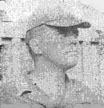 Capt. Rockwell, presently the assistant S-3 of the 3rd Bn., 13th Arty, is a
1961 graduate of Artillery OCS at Ft. Sill, Okla.
Capt. Rockwell, presently the assistant S-3 of the 3rd Bn., 13th Arty, is a
1961 graduate of Artillery OCS at Ft. Sill, Okla.
The captain pointed out that the course is tough and demanding. “Yeu always
have more to do than time allows,” he explained, “As a lower classman you got
only four hours each week (free time) that you can call your own. But the mid
classmen always made sure that your time was utilized with work.”
In addition Capt. Rockwell said good physical shape is a must to make it
through the course.
Six sub-courses make up the basic curriculum at Artillery OCS. Of them all,
the captain emphasized gunnery as the most important subject. Also taught are
surveying, communication, transportation, tactics and combined arms, and normal
officer candidate training that is true of all OC Schools.
Capt. Rockwell recommends OCS for two reasons. First, every
career soldier should perform as well as he can, both for himself and the Army.
Second, graduates who soon return to civilian life will benefit from the
experience of having been a leader as a commissioned officer.
Dental Clinic Has Moved
The 40th Med Det (Dental) has moved its facilities to a new location in the
division base camp. The complete dental service is located in a modified
quonset building adjacent to Ward 4 of the 25th Med Bn and has its entrance on
Oahu Road.
The new building will contain 13 dental chairs, modern high speed dental
drills, complete X-ray facilities, including a dark room for film processing,
and a spacious and comfortable waiting room and reception area.
Beside the quonset there is a similar but smaller building which will serve
as the operational area for prosthetic dentistry dental supply area and
administrative offices. Both of the buildings were constructed by Co A, 65th
Engr Bn.
The detachment commander, Lt. Col. George Kuttas, 39, of Cornwall, N.Y.,
pointed out that the new facilities will lessen the delay in obtaining an
appointment and also make treatment more comfortable for dentists and patients
alike. “Our aim is to keep our standard of treatment equal to that of a
stateside post,” commented Colonel Kuttas.
Since arriving at the Division’s Cu Chi base camp the 40th Med Det has
treated 11,000 patients by extracting, filling, or with artificial appliances.
Thanks to:
The 25th Infantry Division Museum for providing the volume of 1966 Tropic
Lightning News,
Ron Leonard, 25th Aviation Battalion for finding and mailing them,
Kirk Ramsey, 2nd Bn., 14th Inf. for creating this page.
This page last modified
08-12-2007
©2007 25th Infantry Division Association. All rights reserved.